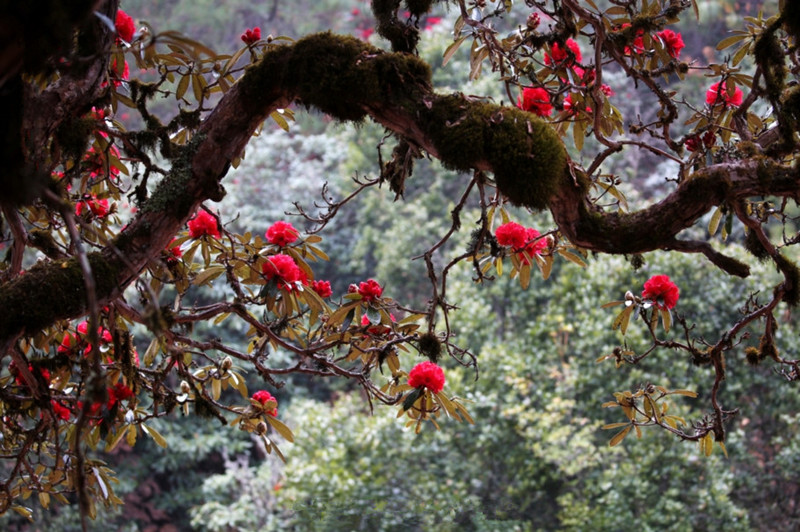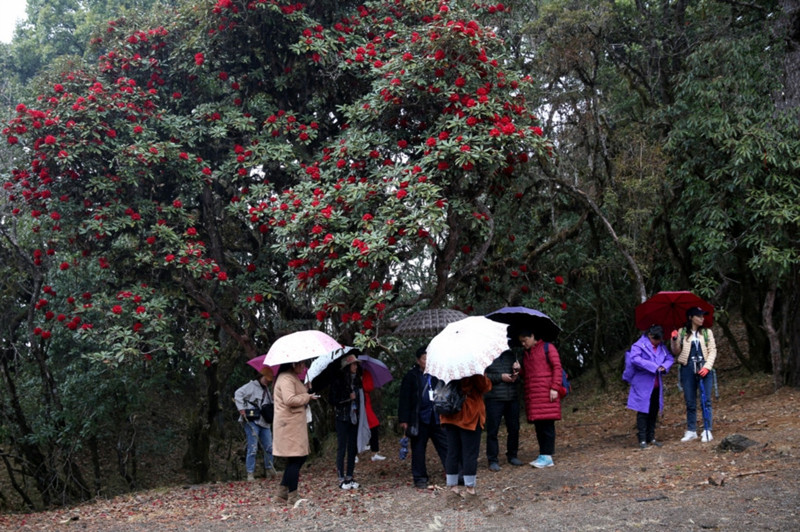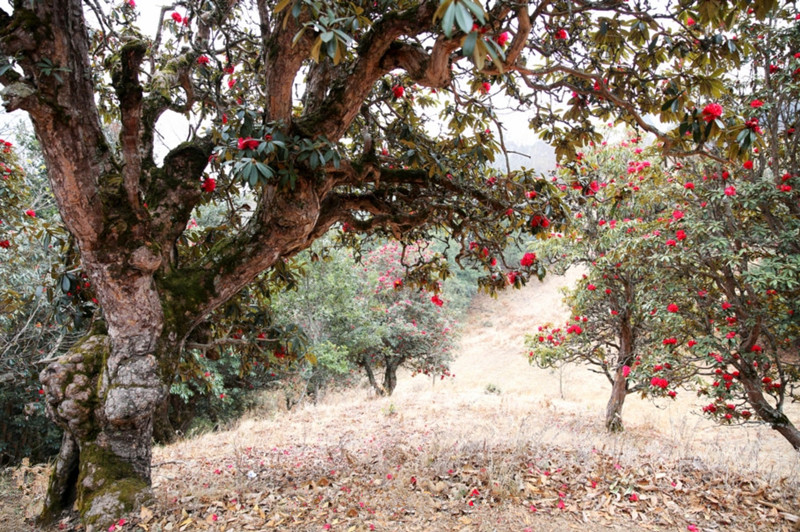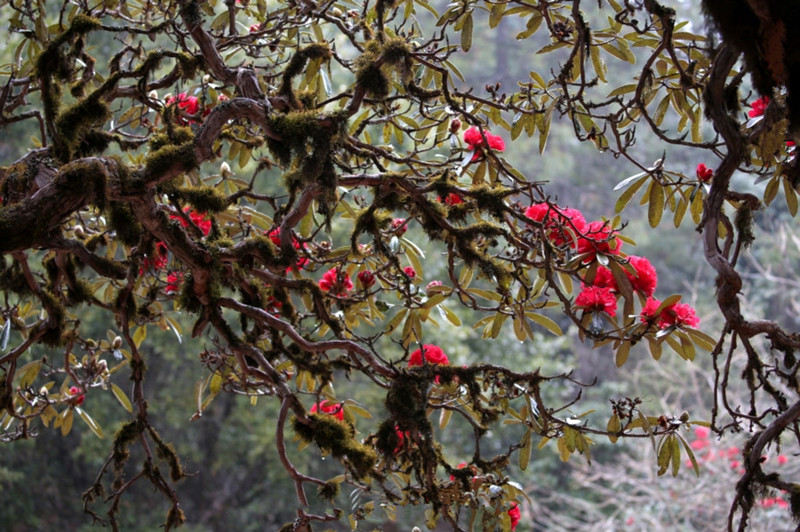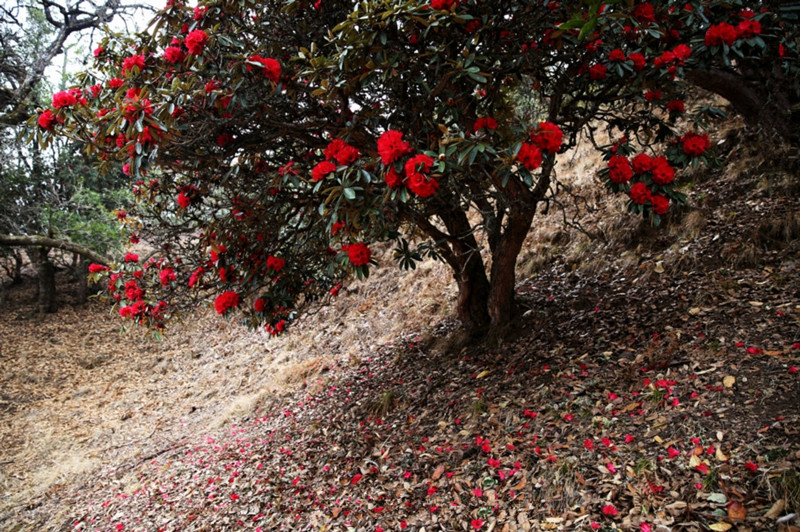West Slope of Cangshan Mountain in Yangbi County, Dali
Overview
The West Slope of Cangshan Mountain (苍山西坡) in Yangbi County (漾濞县), Dali (大理), features the Grand Garden of Cangshan (苍山西坡大花园). Located at the Biqia Peak (笔架峰) on the western slope, this area boasts a high mountain meadow where vibrant red, purple, and white rhododendrons (杜鹃) bloom in spring. Covering over 300 acres, these native large rhododendrons, also known as azaleas or “Ying Shan Hong” (映山红), create a stunning spectacle reminiscent of an original forest or a sea of blossoms, breathtaking for all who visit. The best time to experience this phenomenon is from late February to mid-April.
The West Slope of Cangshan has a more extensive climatic range than the East Slope, resulting in clearly defined vertical vegetation zones. It encompasses a variety of plant types, including all varieties from the subtropical to desert belts, making it the richest area in terms of plant species on Cangshan. This region brings together components from various plant zones, including the Qinghai-Tibet Plateau (青藏高原), the Yunnan-Guizhou Plateau (云贵高原), the western Yunnan canyon (滇西峡谷), and the upper reaches of the Lancang and Yuan rivers (澜沧江元江). Cangshan is home to over 6,000 plant species, with 2,849 species identified across 927 genera and 182 families. Among these, nearly 40 species belong to the rhododendron genus, with 26 species classified as endangered plants by the national government, including 4 species under Class II protection and 10 under Class III. There are 3 endemic species to China, 4 endemic to Yunnan, and 5 endemic to Cangshan.
Plants
- Rhododendrons (杜鹃花): Including Blood Rhododendron (似血杜鹃), Dense Branch Rhododendron (密枝杜鹃), Dali Rhododendron (大理杜鹃), and Fire Red Rhododendron (火红杜鹃).
- Cangshan Fir (苍山冷杉)
- Rhodiola (红景天)
- Cold Arrow Bamboo (冷箭竹)
- Curved Branch Cypress (曲枝柏)
- Yunnan Iron Fir (云南铁杉)
- Red Bean Fir (红豆杉)
- Maple (槭)
- Wild Cherry (野樱)
- Hawthorn (花楸)
- Wild Star Anise (野八角)
- Lead Spring Wood (领春木)
- Yunnan Pine (云南松)
- Silverwood (银木荷)
- Rock Oak (石栎)
- Qinggang Oak (青冈栎)
- Yuanjiang Oak (元江栲)
- Charming Rhododendron (迷人杜鹃)
- Dewdrop Rhododendron (露珠杜鹃)
- Thin Leaf Rhododendron (薄叶杜鹃)
- Camellia (山茶花)
- Big White Flower Rhododendron (大白花杜鹃)
- Banyan (榕)
Historical Development
In 1933, the Provincial People’s Government (云政发(1993)199号) designated the Shimen Pass (石门关) of Cangshan as a provincial scenic area. In 1994, the State Council (国发(1994)26号) recognized Cangshan and Erhai Lake (洱海) as a national nature reserve.
Glacial Features
The glacial remnants of Cangshan are key objects of protection in this nature reserve. In 1937, H. Feismont proposed the theory of the Dali Ice Age. Renowned geologist Li Siguang (李四光) pointed out in 1972 that there was another ice age in China following the Quaternary Lushan Ice Age. This perspective has since gained widespread acceptance and is recognized as the last ice age of the Quaternary, holding significant value for research, education, exploration, and tourism regarding Earth’s evolution, environmental ecology, and geological landscapes.
Yangbi County Overview
Yangbi County (漾濞彝族自治县) is known as the “Hometown of Chinese Walnuts” (中国核桃之乡) and a “Provincial Historical and Cultural City” (省级历史文化名城). This region is often described as Dali’s hidden paradise.
Shimen Pass (石门关) in Dali
The entrance to the West Slope of Cangshan is marked by the natural Shimen Pass, which resembles a massive axe hewn from rock. This stunning geological formation welcomes visitors as they journey along the picturesque Cangshan waters into Yangbi.
Literary Heritage
Famous literary figures such as Xu Xiake (徐霞客) and Yang Shen (杨慎) have paused here, composing beautiful verses inspired by the surroundings. This area encompasses a blend of natural scenery, hot springs for health, and outdoor activities, being a national AAAA-rated tourist attraction.
Nature and Culture
The area showcases a variety of natural wonders characterized by its majestic, dangerous, unique, beautiful, and secluded landscapes, alongside distinct historical culture, ethnic customs, and local traditions. It forms an integral part of the Cangshan World Geopark, the national scenic area, and a national nature reserve.
Yunshang Village (云上村庄)
For those seeking the beauty of rural landscapes, a visit to Yunshang Village (光明村) in eastern Yangbi County is a must, located just 7 kilometers from Shimen Pass. Nestled among ancient walnut trees, this village exemplifies the phrase “a village in the forest, a courtyard amidst greenery, and people among the scenery.” Visitors can enjoy the sound of cicadas and the stories whispered by ancient trees.
Yunlong Bridge (云龙桥)
Yunlong Bridge in Yangbi is the only surviving ancient bridge on the Southern Silk Road (南方丝绸路). Legend has it that a cloud resembling a dragon appeared here, leading to the bridge’s name. The bridge is an iron chain suspension bridge, with pavilions built at both ends, celebrated for its beauty, referred to as “Flying Rainbow over Yang River” (漾江飞虹). Today, Yunlong Bridge has weathered over a thousand years of storms and remains a remarkable historical site.
Yangbi Walnuts (漾濞核桃)
Yangbi is recognized as the first hometown of walnuts in China, with Yangbi walnuts being a specialty product of the Yangbi Yi Autonomous County (漾濞彝族自治县). They are also a national geographical indication product. These walnuts are known for their large fruit, thin shells, white kernels, and fragrant taste, packed with nutrients. They have earned a reputation as the best in their class, exemplifying the saying: “Yangbi walnuts are unrivaled across the land, leading the way for three thousand years.”
How to Get There
By Bus
- From Dali City (大理市): Take a bus to Yangbi County, which takes about 1-1.5 hours.
- From Yangbi County: Local transportation such as taxis can take you to various attractions.
By Car
Renting a car in Dali is an excellent option. The distance to the West Slope of Cangshan is approximately 70 kilometers, around a 1.5-hour drive. Follow signs to Yangbi County and then to the Cangshan area.
Travel Tips
- Best Time to Visit: Late February to mid-April for the rhododendron blooms.
- Hiking Gear: Wear comfortable footwear suitable for hiking and exploring the mountainous terrain.
- Respect Local Customs: Acknowledge the cultural significance of the area while enjoying your visit.
- Photography: Bring a camera to capture the stunning landscapes and vibrant flowers.
- Explore Nearby Attractions: Consider visiting Yunlong Bridge and Yunshang Village for a comprehensive experience.
